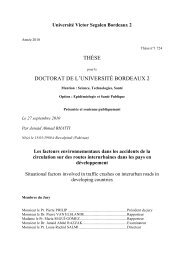Télécharger le texte intégral
Télécharger le texte intégral
Télécharger le texte intégral
Create successful ePaper yourself
Turn your PDF publications into a flip-book with our unique Google optimized e-Paper software.
JOURNAL OF CLINICAL AND EXPERIMENTAL NEUROPSYCHOLOGY2009, iFirst, 1–11NCENEncoding processes influence word-stem comp<strong>le</strong>tionpriming in Alzheimer’s disease: A meta-analysisWord-stem comp<strong>le</strong>tion priming in adXavier Mil<strong>le</strong>t, 1 Mélanie Le Goff, 1 Jean Bouisson, 2 Jean-François Dartigues, 1,3and Hélène Amieva 11 Inserm U897, Université Victor Sega<strong>le</strong>n Bordeaux 2, Bordeaux, France2 Psychology Laboratory EA 4139, Université Victor Sega<strong>le</strong>n Bordeaux 2, Bordeaux, France3 Memory Clinic of the University Hospital of Bordeaux, Bordeaux, FranceDownloaded By: [Mil<strong>le</strong>t, Xavier] At: 10:57 4 November 2009Despite the numerous studies focused on priming performances in Alzheimer’s disease (AD), the question ofwhether word-stem comp<strong>le</strong>tion priming persists in AD is still prone to controversy. Methodological variations,such as encoding instructions, have been proposed to explain the discrepancy of word-stem comp<strong>le</strong>tion primingresults in AD. We conducted a meta-analysis on 678 AD patients and 640 controls to assess whether word-stemcomp<strong>le</strong>tion priming in AD differs according to instructions provided at encoding. When the data across the differentencoding instructions were combined, the results showed that AD patients manifest significant comp<strong>le</strong>tionpriming, even though the magnitude of priming is reduced. Taking into account the different encoding conditions,the results suggested that whereas comp<strong>le</strong>tion priming is impaired in AD when encoding conditions consist inreading or rating words, priming is equiva<strong>le</strong>nt to that of controls when encoding conditions require semanticjudgments or generating words. In this latter condition in particular, self-generating a word at encoding mayprovide an aid to partially overcome conceptual deficits of the patients and increase the degree of adequacybetween cognitive operations employed at encoding phase and those triggering implicit retrieval.Keywords: Implicit processes; Priming; Memory; Review; Dementia.INTRODUCTIONImplicit memory processes continue relatively late inAlzheimer’s disease (AD), representing an attractive perspectivefor rehabilitation strategies. Among the varietyof implicit memory processes, priming phenomenaref<strong>le</strong>ct the impact of prior experience in the form of processingfacilitation without conscious remembering ofthis experience. In AD patients, stimulus presentationfacilitates its subsequent reprocessing in various taskssuch as word identification (Abbenhuis, Raaijmakers,Raaijmakers, & van Woerden, 1990; F<strong>le</strong>ischman et al.,2001; Russo & Spinn<strong>le</strong>r, 1994) and picture naming(Gabrieli et al., 1999; Mitchell & Schmitt, 2006; Park et al.,1998). Two processing distinctions have been proposedto predict priming performances: a view making a distinctionbetween perceptual versus conceptual primingtasks and a second one distinguishing identification versusproduction tasks. According to the first distinction(Roediger, Weldon, & Challis, 1989), perceptual priminginvolves the processing of stimuli physical attributeswhereas conceptual priming involves the processing ofsemantic properties of the material. In AD, normal perceptualpriming has been consistently reported(F<strong>le</strong>ischman et al., 1995; Keane et al., 1991; Koivisto,Portin, & Rinne, 1996; Mil<strong>le</strong>t et al., 2008; Mitchell &Schmitt, 2006; Russo & Spinn<strong>le</strong>r, 1994), whi<strong>le</strong> conceptualpriming has been shown to be impaired (Brandt, Spencer,McSor<strong>le</strong>y, & Folstein, 1988; Lazzara, Yonelinas, & Ober,2001; Monti et al., 1996; Salmon, Shimamura, Butters, &Smith, 1988; Vaidya, Gabrieli, Monti, Tink<strong>le</strong>nberg, &Yesavage, 1999). According to the second distinction—that is, the identification–production distinction—identification priming tasks require participants to verifythe meaning or some particular features of the targetstimulus whereas production priming tasks requireparticipants to generate a response following a cuepresentation. A few studies have directly investigated theAddress correspondence to Xavier Mil<strong>le</strong>t, Inserm U897, Université Victor Sega<strong>le</strong>n Bordeaux 2, 146 rue Léo Saignat, 33076 BordeauxCedex, France (E-mail: Xavier.Mil<strong>le</strong>t@isped.u-bordeaux2.fr).© 2009 Psychology Press, an imprint of the Taylor & Francis Group, an Informa businesshttp://www.psypress.com/jcen DOI: 10.1080/13803390903224936
















